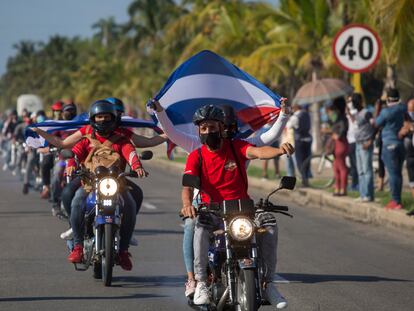Cuba’s Hotel Nacional: the iconic site that hosted Jean-Paul Sartre, Muhammad Ali and Yuri Gagarin
Havana’s landmark destination bore witness to some of the most important transformations in the country following the Cuban Revolution and received numerous illustrious guests
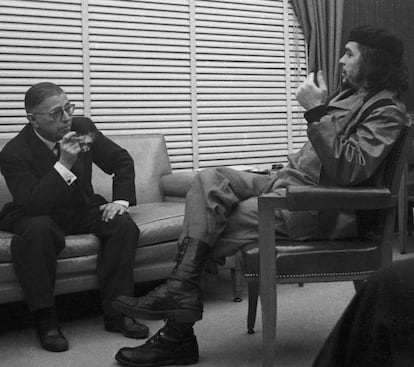
By January 1, 1959, the Havana Hilton, Riviera and Capri hotels had all been built, but the Hotel Nacional de Cuba was still considered the national hotel of the country. Within hours of the Cuban Revolution, the US crime figure Meyer Lansky, known as the “mob’s accountant,” telephoned one of his closest confidants in Cuba, Jaime Casielles, and asked him to hasten to the Nacional. “Lansky knew that [former Cuban president Fulgencio] Batista and his family had fled the country. He said to me: ‘Jaimito, we need to go around all the casinos and collect the money before the hordes are out on the street.” Everything on the island had changed.
For over a year the Nacional remained in the hands of its American owners but it wasn’t long before conflicts with the new government arose and the aristocrats and Hollywood stars started to disappear, although a new clientele would arrive to bear witness to a new era. On February 20, 1960, French writers Jean-Paul Sartre and Simone de Beauvoir checked into the Nacional, having been invited to Cuba by the editor of Revolución magazine, Carlos Franqui. Their objective was to see first-hand the political process that was unfolding.

“We lived in one of the best neighborhoods, in the Hotel Nacional, a luxury fortress, flanked by two crenelated square towers. Of its guests, who came from the United States, only two qualities were required: wealth and taste. As these are rarely reconcilable, if they possessed the first it was assumed, with few inquiries, they had the second,” Sartre would write on his return to France. “I turn the air conditioning up all the way to enjoy the cold of the rich. With 30 degrees in the shade, I go to the windows and watch with sumptuous shudders how those that are passing by perspire. It has not taken me long to find the reasons behind the still indisputable supremacy of the Nacional. It was enough to open the curtains when I arrived: I saw long, graceful ghosts stretching toward the sky.”
The palm trees. The same ones that had dazzled Lucky Luciano and other famous guests. But Sartre and Simone de Beauvoir had not come to Cuba for the trees. The following day, the couple left for Santiago and from there they went to Holguín, where Cuban revolutionary Fidel Castro was inaugurating a school in what had once been a military barracks. There they met the Cuban leader and Argentinian guerilla Che Guevara.

Once back at the Nacional, they were told that Guevara would grant them an audience in his office at the National Bank, the institution he headed, at midnight. “I was still lucky,” recalled Sartre. “Journalists and foreign visitors are received warmly and at length, but at two or three in the morning.” That meeting was immortalized by the photographer Alberto Korda and later described by Sartre in one of the articles he published over the following months in France Soir, and later compiled in the book Hurricane Over Sugar.
“The night did not enter that office. In those men in full wakefulness, the best of them, sleep did not seem to be a natural necessity but rather a routine that they had more or less freed themselves from. I don’t know when Guevara and his colleagues sleep. I suppose it depends: performance decides; if it dips, they stop.” Sartre was also surprised and moved by the youth of the revolutionaries – Castro was 33 and Guevara, 31. “The biggest scandal of the Cuban Revolution is not expropriating farms and lands, but to have brought boys to power,” he said. “Given that a revolution was necessary, circumstances dictated that youth should carry it out. Only youth had experienced sufficient anger and angst to undertake it, and had sufficient purity to carry it out.”
Guevara told them that night that Cuba’s was a “contrecoup revolution,” and Sartre came to the conclusion that it was a process with an ideology “free from elaboration,” perhaps “the most original revolution in the world,” based on “a direct democracy.” When he was asked in an interview what that meant, the author of Being and Nothingness replied: “This Fidel Castro who is continuously on the move in a helicopter or automobile; who often speaks three times a week on the television for hours on end; who explains everything his government does; who discusses every realization; who listens to the peasants and takes note of their complaints; who opens schools in forgotten corners and who argues passionately with his ministers: this is direct democracy.”
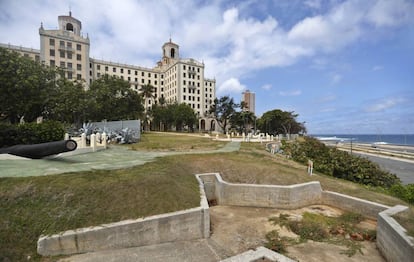
Sartre and Beauvoir traveled all over the island, often accompanied by Castro, and on one of those journeys, one of the great anecdotes of their trip took place. Arriving at a popular tourist spot they asked for a lemonade. It was lukewarm and Fidel complained, asking why Cubans should be subjected to such poor service. The woman replied that her refrigerator was broken and the person who was supposed to fix it had not turned up. As Fidel continued to ask questions, the woman cut the conversation short with a phrase that augured what was to come: “You know how it is.”
On March 4, the explosion of La Coubre in the port of Havana was clearly audible from the Hotel Nacional. The French steamer was anchored there with a cargo of 76 tons of weapons and ammunition for the revolution: 136 people were killed and the following day, during the memorial, Castro gave a famous speech during which for the first time he used his slogan “Homeland or death.” In the stand that day were Sartre, Beauvoir and the main leaders of the revolution, and it was there that Korda took his signature photograph of Guevara, with his beret and defiant gaze, which turned the guerrilla into a global revolutionary icon.
The French intellectuals remained in Havana until March 15, 1960, and a week after they departed the Nacional was expropriated. When Sartre and Beauvoir returned, in October of the same year, the hotel had started to fill with literacy teachers, frontline revolutionary workers and rural villagers from the mountains who had come to Havana to study. The guests at the Nacional were no longer America’s rich and famous.
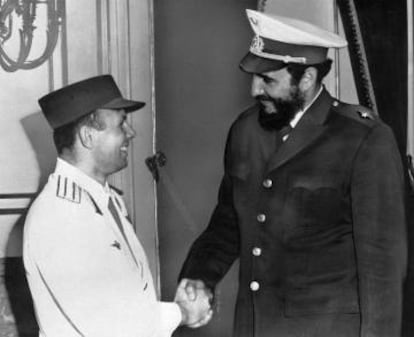
In July 1961, three months after his trip into space, Soviet astronaut Yuri Gagarin arrived in Cuba and met several times with Castro, exchanging caps and participating in the events to mark the anniversary of the 1953 assault on the Moncada barracks. Before delivering his welcome speech, Castro asked Gagarin: “How long did it take you to go around the earth?” The cosmonaut replied: “An hour and a half, comandante.” Fidel smiled and said: “Then start counting.” Today, a bust of Gagarin adorns one of the bars in the hotel, in front of portraits of Venezuelan leaders Hugo Chávez and Nicolás Maduro and the former president of Brazil, Luiz Inácio da Silva, who have all been guests.
The same gardens at the Nacional where Gagarin had strolled were filled with anti-aircraft batteries and trenches a year later, during the Cuban Missile Crisis of 1962. The location of the hotel, on Taganana Hill, made it a key strategic point for the defense of Havana if the situation had escalated, something which did not occur due to the removal of Soviet warheads from the island by Soviet leader Nikita Khrushchev, without consulting Fidel. This did not go down well with the Cuban leader and soon crowds of protestors thronged the seaside promenade on Havana’s shoreline, chanting: “Nikita, sissy, you don’t take away what you’ve given.”
As the revolution became more radicalized and the US imposed its embargo, the Cuban economy was Sovietized and tourism became viewed as an evil, while culture on the island entered its gray quinquennium. The jailing of the poet Heberto Padilla in 1971 on charges of “subversive activities” provoked the rupture of a section of the Latin American and European intelligentsia with the revolution. Among the first signatures on a letter of protest over the Padilla case were those of Sartre and Simone de Beauvoir.
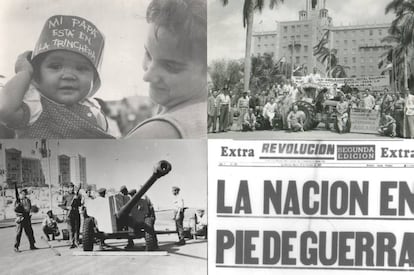
By the mid-1980s Cuba was welcoming only 150,000 tourists per year, half of them from Socialist countries, and the hotels were falling into disrepair. A story did the rounds: a hotel guest was showering when he felt the bath move beneath his feet. Fearing an embarrassing episode, he wrapped himself in a towel and went downstairs to complain. “Look, knowing how things are here, you’re lucky you didn’t end up in the lobby,” the receptionist told him.
A lack of maintenance also started to tell on the Nacional and it was forced to close its doors from 1990-92 to carry out a vast remodeling. When it was reopened, Cuba was in the midst of an economic crisis due to the dissolution of the Soviet Union, which was known as the “Special Period.” Attracting tourists and foreign currency had become a national priority. Cubans were prohibited from staying in hotels so that rooms could be reserved for dollar-paying guests. The crisis hit Cubans hard, with power outages lasting 12 to 14 hours a day and a scarcity of food, medicine and public transportation exacerbated by the toughening of the US embargo. Some American humanitarian organizations started to send aid to the island and one of these missions, in 1996, was headed by US boxing legend Muhammad Ali. Half a million dollars’ worth of medical supplies were distributed and among the party was the US journalist Gay Talese, who had been commissioned to produce a report. In Ali in Havana, Talese recounted the difficulties encountered on that five-day trip, where the former heavyweight champion was feted as a hero wherever he went.
Ali’s hands shook and he could hardly speak due to the effects of Parkinson’s disease, but he was friendly toward his admirers, who stopped him in the great lobby of the Nacional to ask for his autograph. “It took him 30 seconds to write his name on whatever card or piece of paper,” Talese said. “But he wrote it in full, ‘Muhammad Ali.’ He didn’t just write ‘Ali’ to save some time. He has never short-changed his fans.”
The night before they were due to return to the US, Castro invited the group to the Palace of the Revolution. Ali and Fidel mocked up a few punches for the cameras and, as they were leaving, Ali’s wife Yolanda Williams told the Cuban president he would be welcome in their home if he ever visited the US. Castro said that he had been to the US before, to participate in a United Nations General Assembly, but he had not been allowed to leave his hotel room. “But things change,” he added.
However, Fidel Castro was mistaken. Things did not change, tensions mounted and a year later a bomb went off in the Hotel Nacional.
English version by Rob Train.
Tu suscripción se está usando en otro dispositivo
¿Quieres añadir otro usuario a tu suscripción?
Si continúas leyendo en este dispositivo, no se podrá leer en el otro.
FlechaTu suscripción se está usando en otro dispositivo y solo puedes acceder a EL PAÍS desde un dispositivo a la vez.
Si quieres compartir tu cuenta, cambia tu suscripción a la modalidad Premium, así podrás añadir otro usuario. Cada uno accederá con su propia cuenta de email, lo que os permitirá personalizar vuestra experiencia en EL PAÍS.
¿Tienes una suscripción de empresa? Accede aquí para contratar más cuentas.
En el caso de no saber quién está usando tu cuenta, te recomendamos cambiar tu contraseña aquí.
Si decides continuar compartiendo tu cuenta, este mensaje se mostrará en tu dispositivo y en el de la otra persona que está usando tu cuenta de forma indefinida, afectando a tu experiencia de lectura. Puedes consultar aquí los términos y condiciones de la suscripción digital.
More information
Archived In
Últimas noticias
Most viewed
- Sinaloa Cartel war is taking its toll on Los Chapitos
- Oona Chaplin: ‘I told James Cameron that I was living in a treehouse and starting a permaculture project with a friend’
- Reinhard Genzel, Nobel laureate in physics: ‘One-minute videos will never give you the truth’
- Why the price of coffee has skyrocketed: from Brazilian plantations to specialty coffee houses
- Silver prices are going crazy: This is what’s fueling the rally
